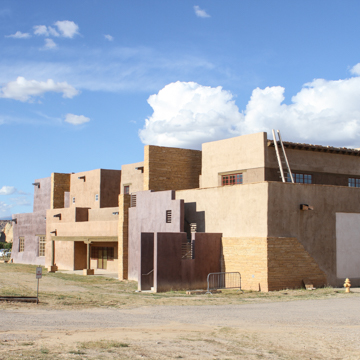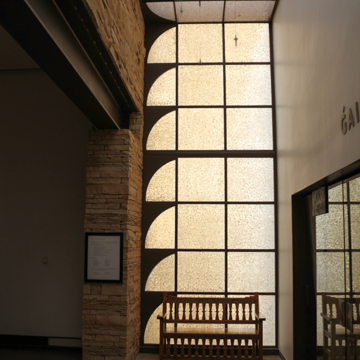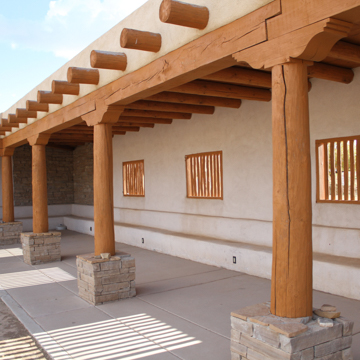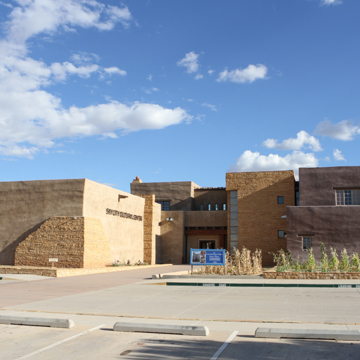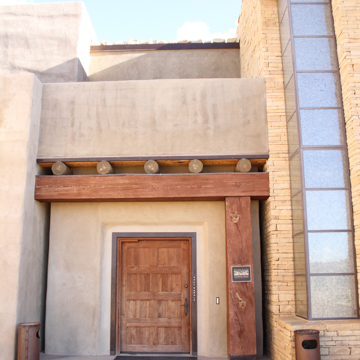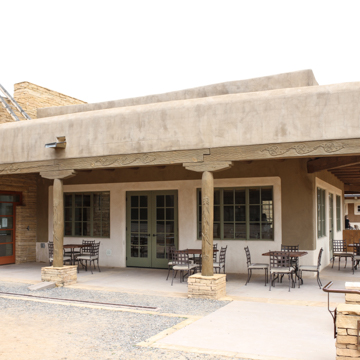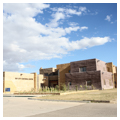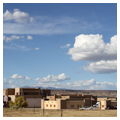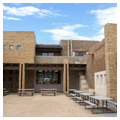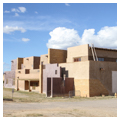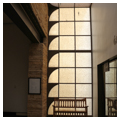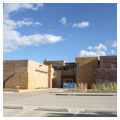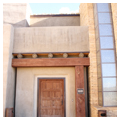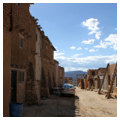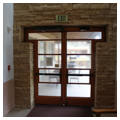The Sky City Cultural Center and Haak’u Museum at the base of Acoma mesa is a gateway for visiting tourists, and represents Acoma’s culture through a modern synthesis of the pueblo’s architectural, visual, and oral histories.
Acoma was among the first Native American tribes to formalize its tourism program, which remains a critical revenue source. In 2000, an earlier tourism center burnt down, necessitating planning of a 40,000-square-foot replacement on the same site. After wide-ranging community consultations, the tribe selected a joint proposal of Barbara Felix Architecture and Design and WoodMetalConcrete Architecture. Submitted with a miniature exhibit of such materials as pottery, stone, adobe, and corn in a steel box designed to reference the pueblo, their proposal became the basis of the present building.
Finished in 2006 and integrating a variety of historical references to avoid fixating on any single period, it accommodates a restaurant, gift shop, meeting rooms, gallery, research library, storage, and restricted repatriation areas. The center’s founding director Brian D. Vallo describes the hope that the building “[…] would bring people home, and […] ultimately represents this grand house that the Acoma people all share, and that we open up to visitors.”
Oriented to landmarks such as Mount Taylor and Acoma Mesa, the center evokes the pueblo’s form with two parallel room blocks, a connecting lobby, and open courtyard between the two blocks. Stepped massing emulates Acoma houses, while vertical windows and wall projections break up its shape akin to the pueblo’s landscape of narrow alleys and rock fissures. Built with a steel frame, autoclaved aerated concrete walls, and finished in stone masonry and painted stucco, its colors and textures reflect those of old Acoma. Sheets of mica window glazing provide fire and UV resistance, and external colonnades incorporate stone remnants from the original building as vending spaces for artists.
Recalling Acoma origins, the Cultural Center restages a search for Haak’u. Visitors approach from the north, passing stone masonry that represents ancestral ruins. The Center’s mass obscures the mesa until one enters its lobby, when the spectacular cliffs and crowning pueblo appear suddenly, visible behind the welcome desk.
The Cultural Center juxtaposes modern steel with Chacoan masonry and references to the Spanish Colonial mission. Corner windows are both modernist tropes and evocations of similar openings in Chaco Canyon Great Houses, while T-shaped doorways echo Aztec Ruin but with the higher jambs of Acoma. At roof level are ladders, parapets, and canales for draining rainwater, and Spanish-style colonnades wrap around the courtyard. Interiors have rounded and square vigas, split-cedar latillas, and corner fireplaces with pottery chimneys. Territorial-era sash windows and cabinetry similar to Housing and Urban Development interiors reference more recent history.
While the building embodies specifically indigenous notions of sustainability, the tribe did not pursue LEED-certification, since some green concepts contradict their idea of natural cycles: for example, water capture would interrupt the free flow of rain. Equally important was the building’s unobtrusive fit into the landscape, in which its style, lack of rooftop mechanical systems, and harmonious materials make it almost imperceptible from the pueblo.
References
Emergence: Sky City Cultural Center. Directed by Rachel Preston Prinz. Archina and Built for Life Productions, 2015.
Molnar, Joy Monice, and Frank Vodvarka. New Architecture on Indigenous Lands. Minneapolis: University of Minnesota, 2013.


















